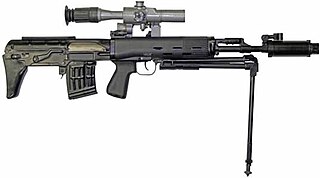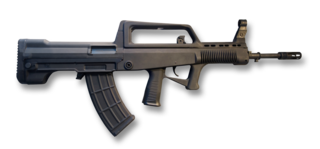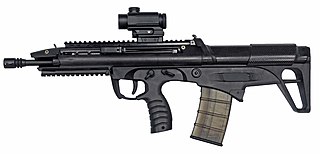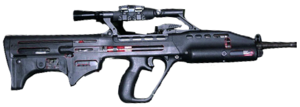
The IMI Galil is a family of Israeli-made automatic rifles chambered for the 5.56×45mm NATO and 7.62×51mm NATO cartridges. Originally designed by Yisrael Galili and Yakov Lior in the late 1960s, the Galil was first produced by the state-owned Israel Military Industries and is now exported by the privatized Israel Weapon Industries.

The SA80 is a British family of 5.56×45mm NATO service weapons used by the British Army. The L85 Rifle variant has been the standard issue service rifle of the British Armed Forces since 1987, replacing the L1A1 Self-Loading Rifle. The prototypes were created in 1976, with production of the A1 variant starting in 1985 and ending in 1994. The A2 variant came to be as the result of a significant upgrade in the early 2000s by Heckler & Koch and remains in service as of 2024. The A3 variant was first issued in 2018 with several new improvements.

A bullpup firearm is one with its firing grip located in front of the breech of the weapon, instead of behind it. This creates a weapon with a shorter overall length for a given barrel length, and one that is often lighter, more compact, concealable and more maneuverable than a conventionally configured firearm. Where it is desirable for troops to be issued a more compact weapon, the use of a bullpup configuration allows for barrel length to be retained, thus preserving muzzle velocity, range and ballistic effectiveness.

The Steyr AUG is an Austrian bullpup assault rifle chambered for the 5.56×45mm NATO intermediate cartridge, designed in the 1960s by Steyr-Daimler-Puch, and now manufactured by Steyr Arms GmbH & Co KG.

The IWI Tavor, previously designated as the Tavor TAR-21, is an Israeli bullpup assault rifle chambered in 5.56×45mm NATO, designed and produced by Israel Weapon Industries (IWI). It is part of the Tavor family of rifles, which have spawned many derivatives of the original design.
The Accuracy International Arctic Warfare rifle is a bolt-action sniper rifle designed and manufactured by the British company Accuracy International. It has proved popular as a civilian, police, and military rifle since its introduction in the 1980s. The rifles have features that improve performance in extremely cold conditions without impairing operation in less extreme conditions.
The karabinek szturmowy wzór 1996 "Beryl" is a Polish 5.56mm assault rifle, designed and produced by the Łucznik Arms Factory in the city of Radom. The rifle replaced the 5.45×39mm FB Tantal used in the Polish Armed Forces; it also replaced the Armed Forces' stock of 7.62×39mm AKM rifles for operational purposes, though reserve and training use of the AKM still continues to a limited degree.

The Ultimax 100 is a Singapore-made 5.56mm light machine gun, developed by the Chartered Industries of Singapore by a team of engineers under the guidance of American firearms designer L. James Sullivan. The weapon is extremely accurate due to its constant-recoil operating system and is one of the lightest machine guns in the world.

The FN F2000 is a 5.56×45mm NATO bullpup rifle, designed by FN Herstal in Belgium. Its compact bullpup design includes a telescopic sight, a non-adjustable fixed notch and front blade secondary sight. The weapon has fully ambidextrous controls, allowed by a unique ejection system, ejecting spent cartridge casings forward and to the right side of the weapon, through a tube running above the barrel. The F2000 made its debut in March 2001 at the IDEX defence exhibition held in Abu Dhabi, in the United Arab Emirates.

The Bionix (BX) is a family of tracked Singaporean armoured fighting vehicles developed by ST Kinetics. Intended to augment the Singapore Army's aging M113 armoured personnel carriers, it is the first indigenous armoured vehicle to be developed in Southeast Asia. The Bionix has been operational with the Singapore Armed Forces (SAF) since 1999 in a wide variety of adaptations including the Bionix II, Bionix 25 and Bionix 40/50 variants.

The Type 95 automatic rifle or QBZ-95 is a bullpup assault rifle designed and manufactured by Norinco, and issued since 1995 as the service rifle for the People's Liberation Army, People's Armed Police, and various paramilitary law enforcement agencies in the People's Republic of China. The rifle's designation "QBZ" stands for "'light weapon' —'rifle' (Bùqiāng)—'automatic' (Zìdòng)", in keeping with the coding standards of the Chinese defense industry.

The OTs-14-4 "Groza-4" is a Russian selective fire bullpup assault rifle chambered for the 9×39mm subsonic cartridge. It was developed in the 1990s at the TsKIB SOO in Tula, Russia.
The SAR 80 is an assault rifle from Singapore.
ST Engineering Land Systems Ltd (STELS), formerly known as ST Kinetics, is a strategic business area of ST Engineering and handles land systems and specialty vehicles.

The STK 50 MG, formerly known as the CIS 50MG, is a gas-operated, air-cooled, belt-fed heavy machine gun developed and manufactured by Chartered Industries of Singapore in the late 1980s, in response to a request by the Singaporean Defence Ministry to replace the 12.7mm Browning M2HB machine guns then in ubiquitous service with the Singapore Armed Forces (SAF).

The BR18 is a bullpup assault rifle made by ST Kinetics of Singapore.
The Fusil Automático Doble is a Peruvian bullpup assault rifle designed by Peruvian arms designer Salomón Braga Lozo and manufactured by SIMA Electrónica.

The Malyuk, sometimes referred to as the Vulcan-M, is an assault rifle developed by the Ukrainian arms company Interproinvest (IPI).
The Ammunition Command is the formation of the Singapore Army responsible for providing the Singapore Armed Forces (SAF) with ammunition, explosives supply chain management and technical support for ammunition. Besides taking charge of the maintenance and storage of ammunition and explosives, they provide support for the fireworks display at national events such as the National Day Parade and Southeast Asian Games.
















